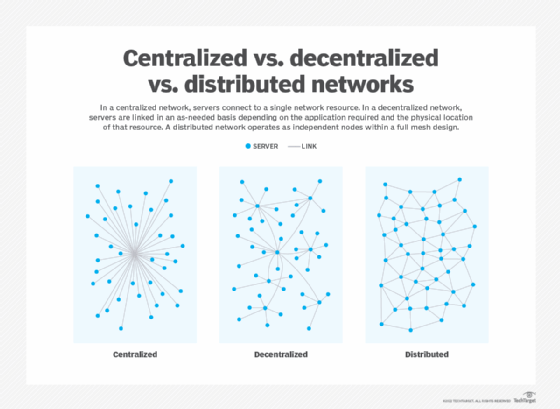
Getty Images
Enhance operations with decentralized data centers
Decentralized data centers enhance scalability, reduce latency and improve data compliance, offering a strategic shift for organizations in modern data management practices.
Decentralized infrastructure in data centers is part of an ongoing modernization and evolutionary process associated with latency-sensitive applications and data sovereignty concerns. While it offers many benefits to organizations that require such structures, it also presents various challenges and management concerns.
Decentralized infrastructure in data centers -- also referred to as decentralized data centers -- improves scalability and resiliency, data sovereignty compliance and reduces latency for time-sensitive applications, especially AI-driven ones. The infrastructure maintains data processing and storage across numerous smaller facilities rather than concentrating them at centralized locations. It improves performance and resilience by enabling each data center to process and store data independently.
This article examines the role, strategy and challenges associated with decentralized infrastructure in data centers, including how it represents a strategic shift in deploying and managing compute, storage and network resources. The article also serves as a guide for IT leaders to decide whether adopting a decentralized infrastructure is a beneficial and realistic strategy for their organizations.
A new strategic approach
IT leadership must consider decentralized infrastructure as a long-term architectural investment. It's not a quick or simple approach, as it fundamentally changes data management within an organization. Think of decentralization in data centers as an evolution of hybrid and cloud deployments rather than an add-on service.
Your organization's new architecture should prioritize designs that balance the typical benefits of decentralization and information processing. Specifically, emphasize the following aspects:
- Performance and reduced latency for modern applications and critical service offerings.
- Reliability and resilience by removing single points of failure.
- Compliance by satisfying data governance mandates, which continue to evolve and change at the national and local levels.
One driving factor for decentralized data centers is associating data processing with existing edge capabilities. Related services must exist to support decentralized data centers, including governance, integration of AI observability, zero-trust security measures and automation.
Decentralized data centers are a major organizational-level shift that can significantly benefit businesses with a defined need. To realize the full benefits, a shift toward decentralizing your business's data centers requires careful attention to architectural design and infrastructure implementation.
Decentralized data centers and edge computing
Decentralized data centers are closely related to edge computing, with both approaches addressing the need for faster and more resilient computing.
Decentralized data centers build on edge computing architectures. Edge computing enables decentralized data centers to process data locally for latency-sensitive applications. Both use IoT structures, rapid 5G and 6G-based communications and AI-driven management.
Potential benefits of decentralized data centers
Decentralized data centers have the potential to revolutionize applications for specific organizations. Not all business models need this capability, but a strategic shift toward decentralized compute resources and data processing can bring significant benefits, which include:
- Additional flexibility. Multiple sites simplify updating and modifying data processing approaches, enabling specialization and location-specific configurations that satisfy compliance requirements.
- Cost efficiency. Localized infrastructure reduces centralized hosting costs, enabling more specific processing capabilities tailored to the smaller data center's role.
- Enhanced resilience. Maintaining multiple locations eliminates many single points of failure, improving availability.
- Improved data sovereignty compliance. As local, regional and national data governance regulations continue to evolve, decentralized data centers can more easily comply with these requirements.
- Improved performance. Processing data closer to its source improves performance, expanding the benefits already associated with edge computing.
- Improved scalability. Decentralization makes scaling data centers up or out easier.
- Reduced centralized infrastructure dependencies. Organizations can create smaller, more specialized, and application-specific decentralized compute locations rather than immense and generalized central data centers.
- Reduced latency. Processing data nearby reduces transmission times and latency, which is critical for many applications.
However, realizing these benefits requires a thorough strategic design and realistic expectations to mitigate the associated challenges.

Potential challenges of decentralized data centers
Recognizing the concerns associated with a decentralized approach to data processing and storage helps organizations overcome the myriad challenges of this architectural shift, which include:
- Data fragmentation, consistency and synchronization considerations. Managing disparate data across multiple sites introduces additional challenges, as each data set requires different compliance management. Data consistency and integrity must also be ensured.
- Design and operational skills. A decentralized approach requires substantial cross-domain expertise in wide-area and edge orchestration, DevSecOps automation, and policy enforcement across hybrid and multi-cloud infrastructures. Architecting and managing this infrastructure requires unique talent that might be challenging to attract.
- Energy and sustainability concerns. A decentralized approach complicates energy optimization and utility service management. It also necessitates working with local utilities, requiring additional vendor management resources.
- Increased operational complexity. Operational management spans various hybrid and multi-cloud environments, increasing the challenges of administering data and network traffic.
- Security. A broader surface area introduces increased security risks. Additional security challenges require AI-driven monitoring, advanced encryption -- blockchain -- and zero-trust models.
These challenges require careful deliberation and planning. Failing to address them could result in a poor return and a more vulnerable security stance.
Common use cases for decentralized data centers
Evaluate whether decentralized data centers fit your organization's business needs and strategies -- not all companies will benefit from this architecture. Consider the following industries that could see a significant ROI from this approach:
- Automotive. This industry focuses on autonomous vehicles and functionality that processes massive amounts of data from cameras, light detection and ranging and radar, requiring processing near the data source for instant decisions.
- Energy and utility industry providers. These industries require dynamic grid management and field data collection for optimization and reliability.
- Financial services. Financial institutions require secure, localized transactions that comply with industry and government privacy regulations.
- Healthcare. Implements healthcare services that analyze wearable devices and process imaging data at the edge to enhance diagnostics and improve response times while maintaining privacy compliance.
- Industrial and manufacturing. These businesses could benefit from AI-based predictive maintenance schedules, automated quality control and process automation on factory floors. These tasks process sensor data locally and benefit from real-time AI analytics. Any organization moving toward an Industry 4.0 transformation should consider decentralized data centers.
- Retail. Offers personalized recommendations, local inventory management and fast checkouts for immediate customer interactions.
- Smart cities. These urban locations use traffic management, utility optimization and other city-wide services through communications and IoT sources, which demand local compute and storage capabilities.
- Telecommunications. Streaming, gaming and other applications that require rapid data transfer for mobile, video and broadcast services rely on edge computing and other real-time processing.
Any industry that relies on generative AI capabilities should consider whether a decentralized data center strategy is worthwhile. The same can be said for organizations experiencing rapid IoT growth, facing stringent data sovereignty demands or working with mission-critical real-time data processing applications.
Damon Garn owns Cogspinner Coaction and provides freelance IT writing and editing services. He has written multiple CompTIA study guides, including the Linux+, Cloud Essentials+ and Server+ guides, and contributes extensively to TechTarget Editorial, The New Stack and CompTIA Blogs.








